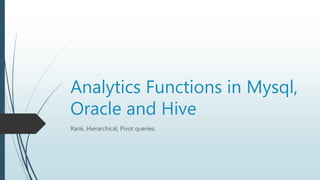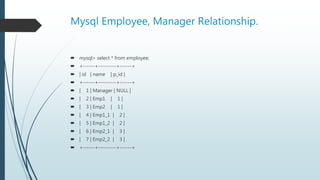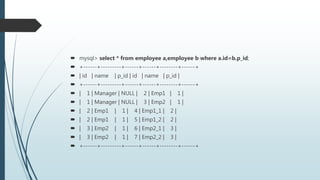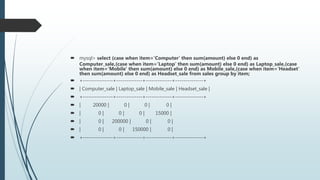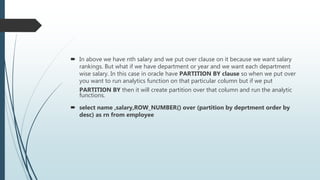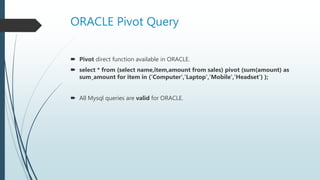Analytics functions in mysql, oracle and hive
- 1. Analytics Functions in Mysql, Oracle and Hive Rank, Hierarchical, Pivot queries.
- 2. Mysql Employee, Manager Relationship. mysql> select * from employee; +------+---------+------+ | id | name | p_id | +------+---------+------+ | 1 | Manager | NULL | | 2 | Emp1 | 1 | | 3 | Emp2 | 1 | | 4 | Emp1_1 | 2 | | 5 | Emp1_2 | 2 | | 6 | Emp2_1 | 3 | | 7 | Emp2_2 | 3 | +------+---------+------+
- 3. mysql> select * from employee a,employee b where a.id=b.p_id; +------+---------+------+------+--------+------+ | id | name | p_id | id | name | p_id | +------+---------+------+------+--------+------+ | 1 | Manager | NULL | 2 | Emp1 | 1 | | 1 | Manager | NULL | 3 | Emp2 | 1 | | 2 | Emp1 | 1 | 4 | Emp1_1 | 2 | | 2 | Emp1 | 1 | 5 | Emp1_2 | 2 | | 3 | Emp2 | 1 | 6 | Emp2_1 | 3 | | 3 | Emp2 | 1 | 7 | Emp2_2 | 3 | +------+---------+------+------+--------+------+
- 4. Mysql Nth Salary mysql> select * from employee; +------+---------+------+--------+ | id | name | p_id | salary | +------+---------+------+--------+ | 1 | Manager | NULL | 300000 | | 2 | Emp1 | 1 | 200000 | | 3 | Emp2 | 1 | 200000 | | 4 | Emp1_1 | 2 | 100000 | | 5 | Emp1_2 | 2 | 100000 | | 6 | Emp2_1 | 3 | 100000 | | 7 | Emp2_2 | 3 | 100000 | +------+---------+------+--------+
- 5. mysql> select max(salary) from employee; +-------------+ | max(salary) | +-------------+ | 300000 | +-------------+ Second (N=2) Highest Salary:- Select col1,col2,salary from tab1 where N-1 = (select count(distinct salary) from tab2 where tab2.salary>tab1.salary);
- 6. In our case:- mysql> select id,name,salary from employee a where 1=(select count(distinct salary) from employee b where b.salary>=a.salary); +------+------+--------+ | id | name | salary | +------+------+--------+ | 2 | Emp1 | 200000 | | 3 | Emp2 | 200000 | +------+------+--------+ Explanation:- Above query called corelated query i.e. inner query is dependent on outer query result.
- 7. So in laymen words our query says:- Get columns with salary from table (select id,name,salary from employee a ) where check in the inner query that how many rows/count is less than our outer query salary (select count(distinct salary) from employee b where b.salary>= 300000) Now if you want have separate department table and you want department wise employee second (nth) highest salary then you have to modify our query with joins:- SELECT DISTINCT d1.deptno,e1.sal FROM emp e1,dept d1 WHERE 2 =(SELECT count(DISTINCT e2.sal) FROM emp e2,dept d2 WHERE e2.sal >= e1.sal AND d2.deptno = e2.deptno AND d1.deptno = d2.deptno) AND d1.deptno = e1.deptno;
- 8. Mysql Pivot Query mysql> select * from sales; +-------+----------+--------+ | name | item | amount | +-------+----------+--------+ | Mark | Computer | 20000 | | Mark | Laptop | 100000 | | Bill | Laptop | 100000 | | Steve | Mobile | 150000 | | Steve | Headset | 15000 | +-------+----------+--------+
- 9. mysql> select (case when item='Computer' then sum(amount) else 0 end) as Computer_sale,(case when item='Laptop' then sum(amount) else 0 end) as Laptop_sale,(case when item='Mobile' then sum(amount) else 0 end) as Mobile_sale,(case when item='Headset' then sum(amount) else 0 end) as Headset_sale from sales group by item; +---------------+-------------+-------------+--------------+ | Computer_sale | Laptop_sale | Mobile_sale | Headset_sale | +---------------+-------------+-------------+--------------+ | 20000 | 0 | 0 | 0 | | 0 | 0 | 0 | 15000 | | 0 | 200000 | 0 | 0 | | 0 | 0 | 150000 | 0 | +---------------+-------------+-------------+--------------+
- 10. ORACLE Employee, Manager Relationship. Now convert all queries in ORACLE and its bit simple because ORACLE give us functions for all this. For Employee Manager or Hierarchal queries we have connect by prior in ORACLE also it give us LEVEL, START WITH kind of functions. select id,name,LEVEL from employee connect by prior id=p_id; ID NAME LEVEL 2 Emp1 1 4 Emp1_1 2 5 Emp1_2 2
- 11. select id,name,LEVEL from employee start with id=1 connect by prior id=p_id ORDER SIBLINGS BY name; https://docs.oracle.com/cd/B19306_01/server.102/b14200/queries003.htm ID NAME LEVEL 1 Manager 1 2 Emp1 2 4 Emp1_1 3 5 Emp1_2 3
- 12. ORACLE Nth Salary For nth salary or similar kind of queries we have some analytical function like ROW_NUMBER(), RANK(), DENSE_RANK() etc. select name ,salary,ROW_NUMBER() over (order by salary desc) from employee; NAME SALARY RN Manager 300000 1 Emp2 200000 2 Emp1 200000 3 Emp2_1 100000 4
- 13. Now comparing all three in one query:- select name ,salary,ROW_NUMBER() over (order by salary desc) as rn,RANK() over (order by salary desc) as ranks, DENSE_RANK() over (order by salary as dense_ranks from employee; NAME SALARY RN RANKS DENSE_RANKS Manager 300000 1 1 1 Emp2 200000 2 2 2 Emp1 200000 3 2 2 Emp2_1 100000 4 4 3 Emp1_2 100000 5 4 3 Emp2_2 100000 6 4 3 Emp1_1 100000 7 4 3
- 14. In above we have nth salary and we put over clause on it because we want salary rankings. But what if we have department or year and we want each department wise salary. In this case in oracle have PARTITION BY clause so when we put over you want to run analytics function on that particular column but if we put PARTITION BY then it will create partition over that column and run the analytic functions. select name ,salary,ROW_NUMBER() over (partition by deprtment order by desc) as rn from employee
- 15. ORACLE Pivot Query Pivot direct function available in ORACLE. select * from (select name,item,amount from sales) pivot (sum(amount) as sum_amount for item in ('Computer','Laptop','Mobile','Headset') ); All Mysql queries are valid for ORACLE.
- 16. Hive Queries All mysql queries can be applied as it is but slight change like for string have to use double quotes etc. Also from hive 0.11 we can use analytics function like ORACLE. https://cwiki.apache.org/confluence/display/Hive/LanguageManual+WindowingAn dAnalytics#LanguageManualWindowingAndAnalytics- WindowingandAnalyticsFunctions
